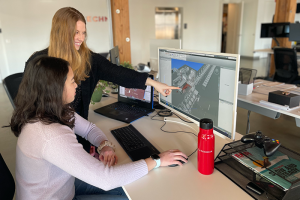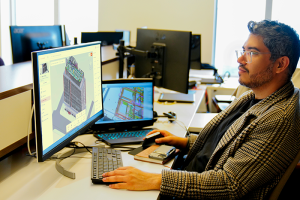Patient engagement sees improvement

The hospital chose 32-inch screens for the best content display for patients based on room size.
Image by Gregory Mahabee, NYC Health + Hospitals/Queens
Patients at NYC Health + Hospitals/Queens are reaping the benefits of a project that kicked off three years ago. As part of New York City’s public health care system, the 253-bed hospital has been serving the communities of central and southeastern Queens since 1935 and has undergone several major additions and improvements over its lifetime.
One of its latest projects aimed at improving patient satisfaction and clinical outcomes has been replacing and upgrading its patient entertainment and education system.
Before the project kicked off, patients walking into one of NYC Health + Hospitals/Queens rooms were greeted by an analog, low-definition satellite TV feed distributing content to an old-fashioned tube television. The system didn’t offer many options with regard to patient engagement and education, which meant nurses often spent longer times teaching patients about their care, taking time away from administering care.
The hospital wanted to improve how it connected and engaged with patients, which led to it replacing its former sets with 32-inch Pro:Centric health care TVs from LG. The LG TVs are designed to work with most pillow speakers, and also were compatible with the hospital’s new content management system, TigrPX, created by TeleHealth Services, Cary, N.C. TigrPX is an interactive patient engagement solution built on cloud-based technology.
NYC Health + Hospitals/Queens chose the 32-inch flat-panel HDTVs based on room dimensions to help patients clearly and comfortably see everything on-screen. The team at TeleHealth Services integrated RF distribution technology with all the TVs so they could receive not only entertainment channels from the new Spectrum TV cable headend, but also digital education and information delivered through TigrPX via the hospital’s network.
The new pillow speakers enable the patients to operate the LG hospital TVs and TigrPX system. TeleHealth Services programmed an intuitive, tiled home screen, giving users access to TV content, hospital information, a set of programmable preferences and a catalog of patient education.
The TigrPX system interfaces with the hospital’s admission, discharge and transfer system to identify who is in each room, and they communicate back and forth with nurses station computers so staff can assign appropriate content to each patient.
When the system launched in October 2020, the hospital could access a library of about 250 education videos in English and Spanish, as well as with closed captions. Today, the content library has doubled.
“One of the best things is that the system is flexible and allows us to produce our own videos,” says Marzya Sdrewski, associate executive director of operations at NYC Health + Hospitals/Queens. The hospital’s content library already includes important patient information about COVID-19, for example.
“Previously, there would be lots of information to give patients just as they were leaving the hospital,” Sdrewski says. “Now, with the new interactive TV system, we have a chance to start educating patients much earlier. We can schedule videos based on their prognosis, including content that helps reinforce prescribed treatment or medications they should be taking.”
The nursing staff has embraced the LG hospital TVs and the TigrPX system because the solution helps them deliver personalized care to more patients. The hospital’s patient satisfaction scores have already started to improve, and early indications are that patients enjoy and use the system, so nurses know people are getting the health education they need. Nurses can spend more time treating patients as patients use the LG/TigrPX solution to comprehend material.
Looking ahead, NYC Health + Hospitals/Queens is planning further enhancements with its LG-based TigrPX solution. Plans are underway to integrate it with the hospital’s electronic medical records system, enable patients to request services via the interactive TVs and expand the education library to include videos in more languages. The hospital also plans to install LG TVs in more care spaces.




